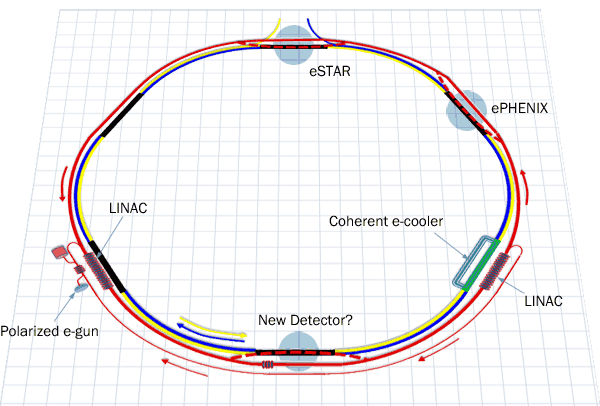eRHIC: Colliding Electrons with Ions at RHIC
June 12, 2012
There are compelling reasons to build an electron-ion collider (EIC) at Brookhaven National Laboratory, not the least of which are the Lab’s rich physics history, accelerator expertise, and the existence of a fully functional and productive proton/heavy-ion accelerator/collider — that is the Relativistic Heavy Ion Collider (RHIC) — and its international collaborations of physicists eager to continue their explorations of matter. Adding an electron ring and other accelerator components to the existing accelerator complex would be a cost-effective, practical strategy for achieving the scientific goals of an electron-ion collider.

A schematic of the design for adding an electron ring (red), and possible future detector, to RHIC to create eRHIC, which would be the world's first electron-ion collider (EIC).
The current proposed design for an EIC integrated with RHIC — dubbed eRHIC — calls initially for the addition of a 5 to 10 billion-electron-volt (GeV) electron ring inside the existing RHIC tunnel, with a layout that allows subsequent straightforward upgrading of the energy, ultimately to 20 or even 30 GeV.
Electrons would be accelerated by two stacked energy recovery linear accelerators (ERLs) and collide with heavy ions or protons circulating in one of the existing RHIC accelerator rings. No new civil construction would be required to accommodate this design, making it particularly attractive from a cost perspective.
The design would also benefit from another proposed installation: a separate small coherent electron cooling ring designed to keep the velocity of heavy ions/protons in RHIC’s beams highly uniform, and thus tightly bunched, to achieve the highest luminosities, or collision rates. Such a beam-cooling system would be essential to achieve the highest luminosity required for a considerable fraction of the EIC physics program.
eRHIC would be the world's first electron-nucleus collider. It would have the flexibility to change the nuclear ion species as well as the beam energies — both crucial for the systematic study of the “glue” postulated to dominate the internal structure of heavy nuclei accelerated to near light speed. For electron-proton collisions, eRHIC would be the world's first fully polarized electron-ion collider (that is, where both the electron and proton/ion beams are polarized). And the eRHIC luminosity would be at least 100 times that of the former HERA accelerator at DESY.
“What HERA could do in years, would be just a matter of weeks at eRHIC. And without polarized proton beams, HERA could never study the proton's spin structure,” said Stony Brook University physicist Abhay Deshpande, noting that the HERA measurements of unpolarized (spin-independent) proton structure would serve as a baseline for studies at eRHIC.
The eRHIC design also considers a new specialized detector to analyze collision results, possibly in addition to upgrades that would enable RHIC’s existing STAR and PHENIX detectors to make key precision measurements.
Brookhaven accelerator physics and engineering staff are currently hard at work on engineering studies to produce a detailed design for the 5 to 10 GeV electron ring, incorporating the ERL accelerator, that will fit within an initial investment of approximately $500 million. Additional funding would be required to construct a new detector or later accelerator upgrades.
2012-3145 | INT/EXT | Newsroom









